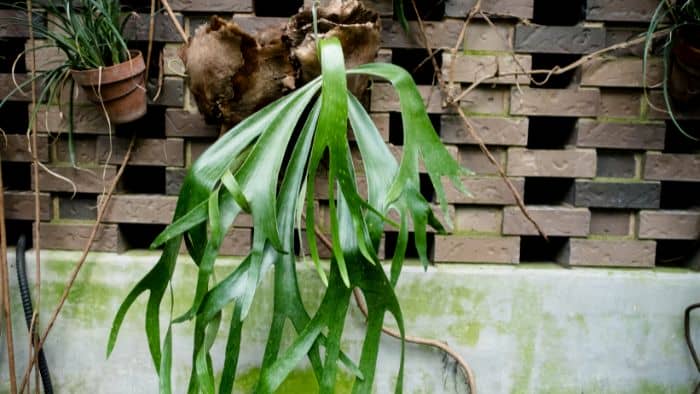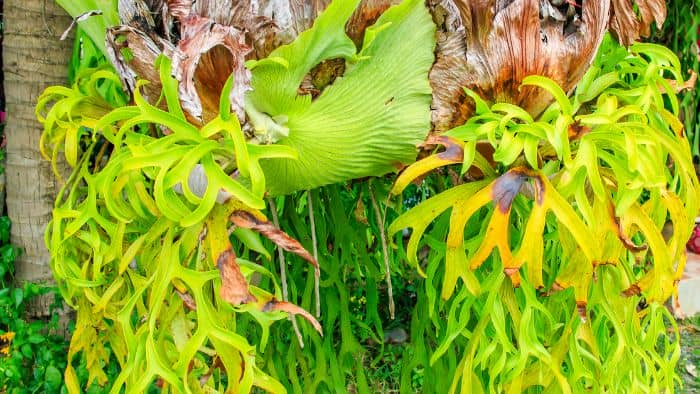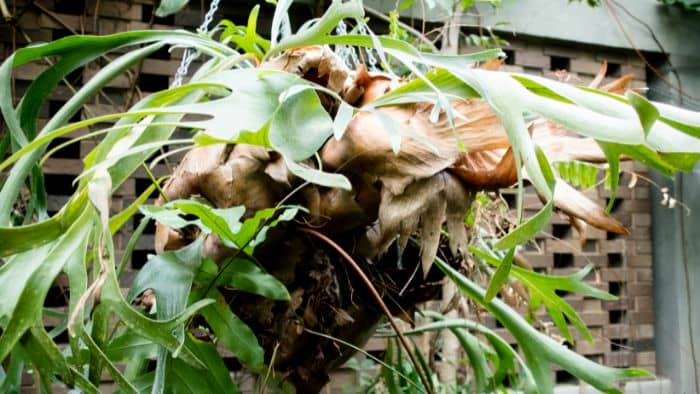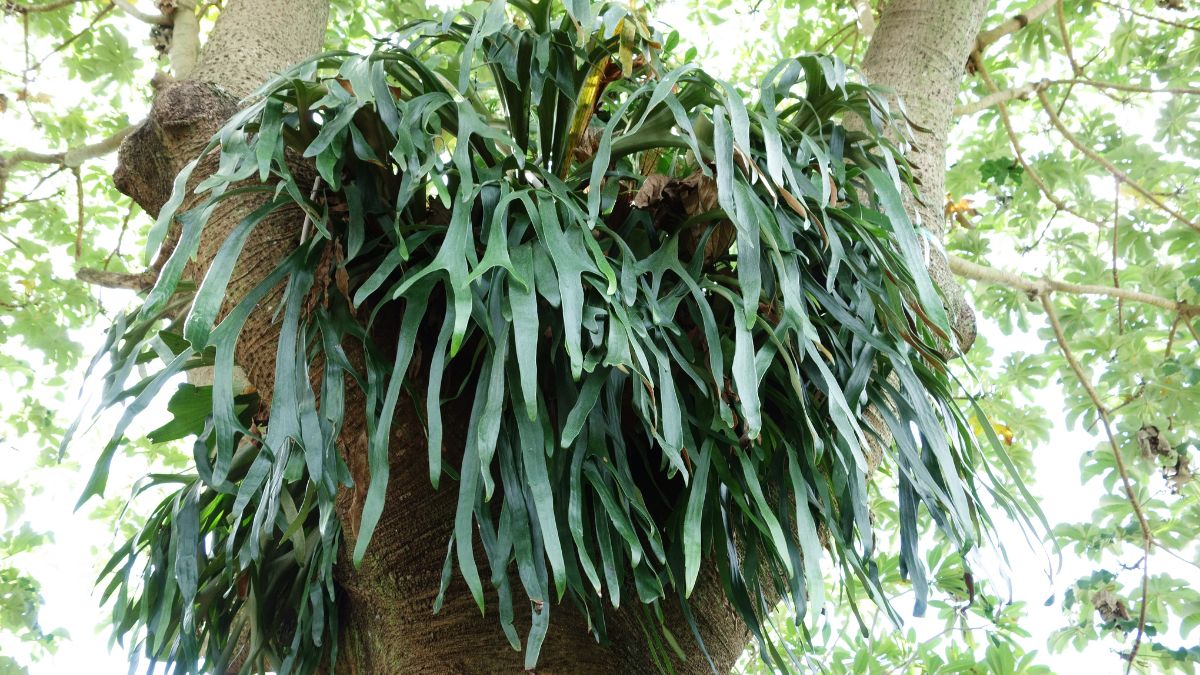Using the Best Soil for Staghorn Fern will afford you a healthy and happy plant all year through. This blog post is to enlighten you about the history of these beautiful fern plants, soil types that allow them to grow their best, and much more.
If you’re thinking about growing staghorn ferns indoors or outdoors, it is important to have knowledge of the correct maintenance and care tips to help them thrive. Although these plants are not very demanding, giving them proper care will ensure that they reach their full potential.
Aside from that, these attractive plants lend a magnificence of beauty to any landscape or home. Have a quick run through the article below and learn all about growing these evergreen plants!
A Little History Of Staghorn Fern Plants
Native to the tropics of New Guinea and Australia, staghorn fern or Platycerium bifurcatum are plants that grow best in humid areas. Because the plant’s leaves resemble deer antlers, its name is well suited to its appearance. These plants are usually found growing on trees where moderate sunlight filters through.
Depending on the growing conditions, staghorn ferns can sprout to at least 4 feet. This is because the soil recommended for these plants has the same properties as the native areas to which they are accustomed.

Staghorn ferns grow well indoors or outdoors as aside from growing on tree trucks, they also adapt and grow easily on wire and rocks. For this reason, these plants are an excellent choice for landscaping and decor purposes.
What Is The Best Soil For Staghorn Fern?
Staghorn is an epiphytic plant that grows best in soil that is loose and well-draining. Soil that has excessive moisture is not recommended for this plant as it can cause disease and stump its growth. Although the staghorn ferns don’t like water-logged soil, they also are quite fussy about soil that is too dry.
Therefore, the best soil for staghorn fern is a nutrient-rich cactus potting mix with equal parts orchid bark or peat moss. The reason for this is that peat moss helps with water retention, ensuring that the soil is not too wet or dry. If you are planting your fern outdoors, it is important to know that gardening or mineral soil is not recommended. A planting medium rich in organic matter is best.
The reason why it is vitally important to learn about using the soil type that is most suited for this plant is that your plant can get destroyed if grown in the wrong environment. Watch the next video to learn all about staghorn fern.
Best Planting Method For Staghorn Fern
Staghorn fern plants are a great addition to any garden. Aside from them being quite easy to grow and care for, these plants shed lush greenery when grown in regions with high humidity. However, using the best soil for staghorn fern together with the correct climate and maintenance will contribute immensely to their health.
These plants can be propagated in several different ways. When growing in the wild, they spread and reproduces naturally from spores. This planting method can also be used in home gardens and is often favored by avid gardeners. This is because growing staghorn fern from spores is a simple method. Follow the steps below and get planting.
Staghorn Fern Planting Steps:
- The best time to check for spores from staghorn fern plants is in the summer season. The spores can be found underneath the leaf fronds and should be monitored as it darkens through the season.
- Thereafter, towards the end of the summer season, extract the spore fronds and bag them. A paper bag will work perfectly in this instance.
- Wait for the fronds to become completely dry before extracting the spores. This could take a while depending on how they are stored and the climate in your region.
- The next step is to fill a small container with peat moss.
- Then, sprinkle the spores on the top of the peat moss and slightly push them down. This is to settle them on top and not to bury them.
- You can now cover the container and leave it in a sunny spot as the spores germinate. This is a long process so patience is key. The usual waiting period for germination can be anything from 3 to 6 months.
- Ensure that the spores are watered from time to time. The soil should be damp, so don’t overwater.
- Repotting or transplanting can be done after a year.

Staghorn Fern Plant Care Tips
Staghorn ferns are easy to maintain and spotting problems in your plant is the first thing to do to ensure you give them the proper care promptly. Pale or scorched foliage is indicative of excessive sunlight exposure while patchy or spotted leaves are caused by overwatering. If your plant is exposed to dry air or is placed near an air conditioner or in the direct path of cold drafts, browning fronds are the first tell-tale signs. Without proper care, your plants can also develop diseases that can stump their growth.
Listed Below Are A Few Plant Care Tips That You Can Follow:
- Sunlight – It is best to grow your plant under filtered light that is bright. Direct sunlight for long periods of time is not recommended as it can flaw the foliage.
- Plant Pot – If you’re growing this plant indoors, ensure that it is planted in a large enough pot. This is because staghorn ferns grow up to 1 meter high and approximately half a meter wide indoors.
- Watering – Summer and spring are growing seasons for these plants. During this time, ensure that they are regularly watered. However, do not overwater.
- Climate – This plant thrives in areas with moderate humidity. Misting your plant from time to time is recommended.
- Soil Type – Staghorn fern has fibrous roots that are small. They grow best in a mixture of equal parts peat moss, bark, and sphagnum moss.
- Repotting – Although repotting this plant is not necessary, it is best to transfer them in the early spring season.
Conclusion

So, we have given you the ins and outs of the best soil for staghorn fern, their history, growing methods, and plant care tips above. Using the information in this article will afford you healthy and happy plants for a long time.
These hardy plants are an asset to any indoor and outdoor garden as their leaves are beautifully fanned out to display their stance. Also, staghorn fern plants store and circulate water and nutrients from their leaves. Therefore, they are hardy enough to tolerate drought.
However, you need to keep in mind that giving them the proper care is vital to ensure longevity. Without it, they will be exposed to pests and diseases that might be a task to overcome. Keeping them in the best health should be a priority! Click on the link for more info about these hardy plants.
FAQs
[rank_math_rich_snippet id=”s-2dff1a1e-6d58-4abc-bb35-2dbc98ea886e”]

